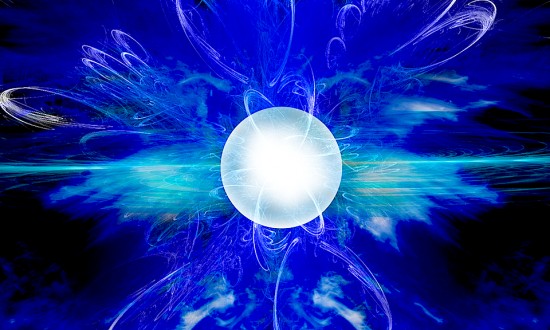May 16, 2014
A toroidal magnet field is said to be embedded in a magnetar.
“Magnetars” are usually classified as “X-ray pulsars (AXP)” or “soft gamma repeaters (SGR)”. As conventional theories argue, they are created when neutron stars reach magnetic field strengths measuring over 10^15 Gauss. Earth’s magnetic field is about one-half Gauss, so these “magnetic pulsars” are surprisingly powerful sources. It must be stressed, though, that the evidence is indirect and no neutron star has ever been observed.
According to a recent press release, researchers working with the Suzaku X-ray Observatory discovered a “toroidal magnetic field” embedded in a magnetar. Suzaku was launched on July 10, 2005. On July 29th and then again on August 8th, helium leaks caused the cryogenic cooling system protecting its X-ray spectrometer to fail. However, onboard Suzaku are an X-ray Imaging Spectrometer and a Hard X-ray Detector, so its mission was reconfigured to make use of the remaining detectors.
What the mission specialists found was a pulsar, labeled 4U 0142+61, that is not behaving in the way pulsars should behave. They are supposed to be so stable that they act like timing beacons in space, ticking away at regular intervals. However, 4U 0142+61’s 8.7 second beat reveals irregularities: sometimes its signal arrives early, sometimes a little late. Pulsars are important to astrophysical models because they are used as measuring tools. Those with “known” distance, coupled with variations in their luminosity, are thought to be road markers in space, so that the distances of other stars with similar characteristics can be determined.
The only explanation that the Suzaku team can come up with is that intense toroidal magnetic fields more than 10^12 Tesla are squeezing the pulsar into a football shape, causing it to exhibit “axial precession” as it spins, just like a quarterback’s spiral pass will wobble slightly through the air.
What astronomers actually observe are intense, localized magnetic fields, pulsing in fractions of a second, like 4U 0142+61. Some magnetars have also been detected emitting gamma ray bursts described as “star quakes”. Since the mass per unit volume in a pulsar is supposed to be so great, any rapid movement in the crust is reported to create intense “magnetic reconnection” that generates gamma rays. The problems with magnetic reconnection notwithstanding, magnetars are one version of imaginary constructs created by astrophysicists when they try to explain energetic events without sufficient gravity.
It is a well-established fact that magnetic fields are induced by electric currents. Therefore, there must be an electric current generating the intense fields in magnetars. It is also indisputable that the input current must exist in a circuit, since persistent electric charge can only move that way.
Many Picture of the Day articles take issue with neutron star theory, in general, since it violates the laws of classical physics. Professor Donald Scott, author of The Electric Sky, wrote: “The ‘neutron star’ is simply yet another fantasy conjured up, this time, in order to avoid confronting the idea that pulsar discharges are electrical phenomena. A nucleus or charge free atom made up of only neutrons has never been synthesized in any laboratory nor can it ever be. In fact, a web search on the word ‘neutronium’ will produce only references to a computer game—not to any real, scientific discussion or description. Lone neutrons decay into proton/electron pairs in less than 14 minutes; atom-like collections of two or more neutrons will fly apart almost instantaneously.”
Professor Scott proposes that pulsars are relaxation oscillators; their pulse frequencies are not mechanical. Instead, they are caused by the capacitive, resistive, and inductive electrical environment around a star. Electricity traveling through circuits provides a coherent explanation that is consistent with commonly accepted electromagnetic theories, as well as with laboratory experiments.
For astronomers to report that they discovered toroidal magnetic fields embedded in a magnetar is tantamount to reporting that they discovered unicorns with braided tails.
Stephen Smith













